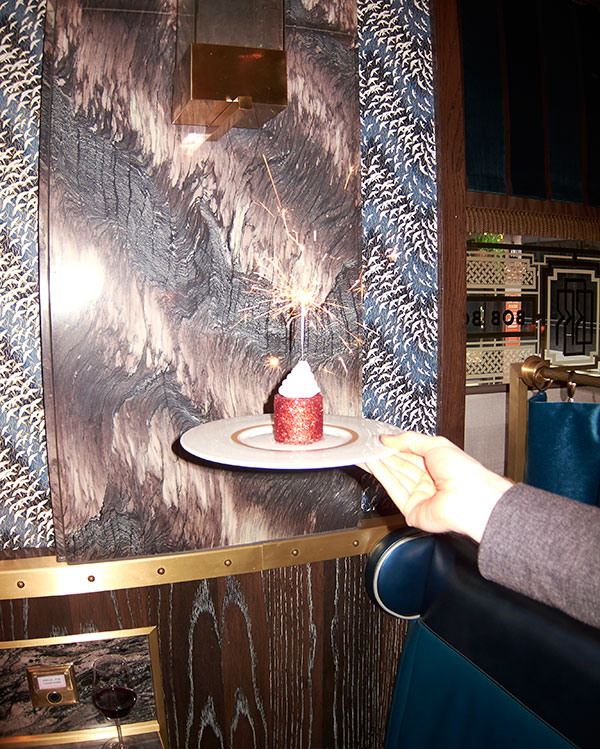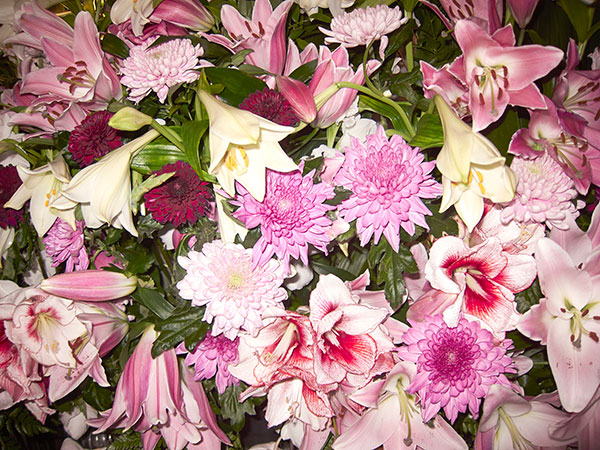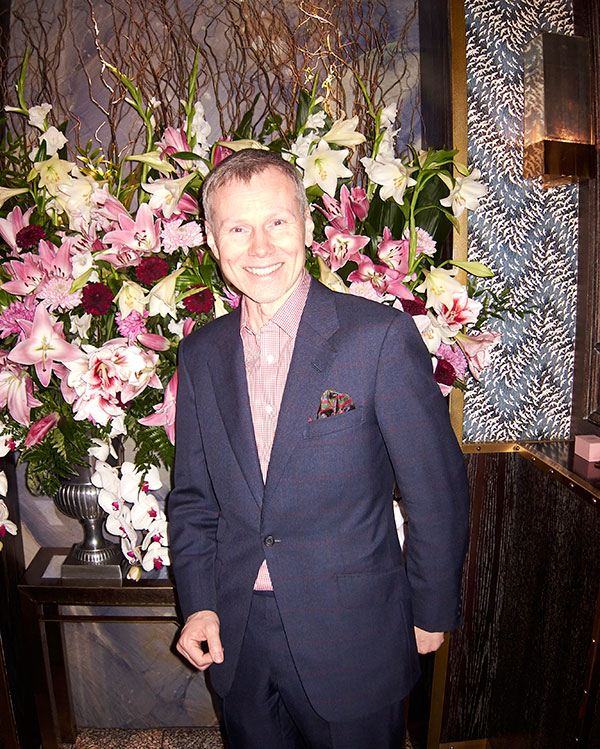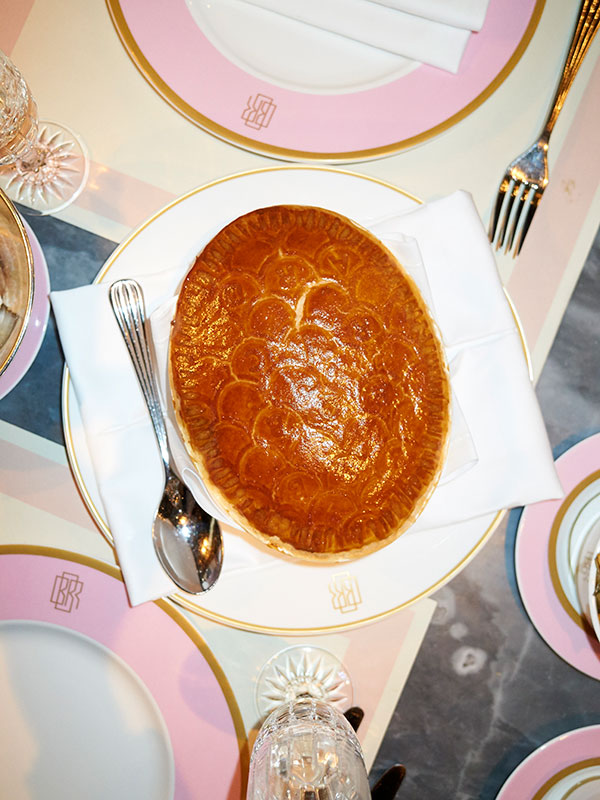A square meal: how restaurants are courting the Instagram crowd

Simply sign up to the Life & Arts myFT Digest -- delivered directly to your inbox.
Leonid Shutov pulls out his phone. It’s just past breakfast in London, and he is sipping an espresso at a green banquette inside Bob Bob Ricard, his restaurant on the corner of Upper James Street and Beak Street in Soho. This is the kind of place that, like fabulous wealth or a bad hangover, isn’t seen much before lunchtime. It’s too delicate.
The walls are lined with chiyogami bookbinding papers imported from Japan, a dappled pattern of silver cranes flying across an ink-blue night. At each table there is a button in which capital letters spell out: “PRESS FOR CHAMPAGNE”. A huge blousy bouquet of pink flowers overwhelms the bar, where, later on, they’ll be serving fine vodkas at -18c.
What the 50-year-old restaurateur, in his cheerful accent (half native Russian, half adopted English), opens up Instagram to show off is a photo of a drinks coaster. “Just this morning, I was looking at someone in San Francisco posting a picture of one of our coasters,” he says proudly. In the comments underneath the post, Shutov notes, somebody else had deduced from the coaster’s livery that it was from Bob Bob Ricard. “BBR” has a light gold, art deco logo that adorns much of a meal here, from the plates to the menu to the coaster to the billfold.
“There’s a value of having someone be able to recognise that. If you search on Instagram by London restaurants and food, a lot of beautifully executed shots come up on fine china but you’d be hard pressed to say where they were without looking at the geotags to identify them easily.”
Food is a great feeder of Instagram — some 208 million posts have been tagged on the photosharing app with the “food” hashtag since it was founded in 2010 — and, for a restaurant like Shutov’s, it is a branding opportunity. The photographic revolution sparked by the modern mobile phone and its inbuilt camera means that a large number of consumers arrive with a nuanced understanding of what might make an appealing image on a forum such as Instagram.

Increasingly, as the social sphere becomes more crowded, the challenge for a restaurateur is to anticipate the customer’s visual tastes correctly — to create tables, dishes and settings that are photographs waiting to happen. Shutov almost always uses pictures on his restaurant’s Instagram feed that customers have taken themselves.
It creates a flattering reflection of the good times people have at BBR, while also reinforcing the graphic identity of what is a relatively small restaurant with 176 covers, best known for those PRESS FOR CHAMPAGNE buttons and the gallons of fizz it drinks through as a result — “more than 3,000 bottles in a slow month,” Shutov says.
“We absolutely love social media — as far as restaurants go, it’s the great equaliser. It’s amplified word of mouth. You can’t distort it easily but it allows you to bypass a lot of the conventional media. Stories that wouldn’t be big enough to make it on to conventional media will flourish on social media, and that’s very important to us.”
Which is why Shutov, who founded an advertising agency in Russia that he sold in 2007 to Ogilvy, and opened BBR in 2008, has just invested an undisclosed sum in making his restaurant more Instagrammable. That means whiter plates, clearer logos, pretty photo-catching new dishes such as chicken Kiev in a bonnet shape, truffled fries and a goat’s curd and beetroot starter that looks like a Parisian petit four.
“We always had people photographing the table when it’s filled with food,” Shutov notes, with the Beef Wellington and Chocolate Glory popular choices, “however, as soon as we changed to new plates, people got excited; we know we’ve done something right.”
***

Instagram began with a yellow fluffy dog at a taco stand in Mexico. The first image on the photo-sharing app was taken in Todos Santos by its co-founder Kevin Systrom, of a Labrador lying winsomely at his girlfriend’s feet. After being uploaded to a test site, the photo — and Instagram — went live in October 2010. The rest, Systrom said, “is history” — people flocked to the idea of retro square-format photos that could be processed on their phone through different “filters” and edited for effect, creating public albums of whatever a person wanted to show from their life (barring full nudity).
Now Instagram is much more than that: a platform for businesses in fashion, food and media to net new interest in their products, to play with brand identity and to make instant impact when they need to refresh a corporate image that’s going stale. Not every brand uses it well, but Instagram counts 600 million monthly active users worldwide and was sold to Facebook for $1bn in 2012.
Last year, to keep pace with the more youthful aesthetic of its rival Snapchat, it introduced “Stories”, a feature that enables users to upload snippets of video and photos that they’ve taken in the past 24 hours, which then disappear after a day — a little self-dissolving diary that is like an extra window into someone’s life. Like much of Instagram, it can become addictive.

This allure is part of what makes hospitality designers now include Instagram in their thinking right from the drawing board. Afroditi Krassa, who has her own design studio based in London, has worked for clients from Heston Blumenthal to Curzon Cinemas. She has been in the industry for 15 years so, like the original interior of Bob Bob Ricard, her experience pre-dates the explosion of social media. Should Instagram be part of the modern restaurant’s strategy? “One hundred per cent yes,” she says, sitting in Bala Baya, the Bermondsey pitta café-bar she designed and invested in. Housed in a converted railway arch, it has an open kitchen, white marble counter and a huge chandelier hanging from the Victorian brick ceiling.
Over the day’s lunch special of orange-and-harissa fried chicken in fresh-made pitta wraps, Krassa explains her view of social media and its role in hospitality marketing: “It’s still word of mouth but the mouth is Instagram. Hoteliers were ahead of the game — they sell their product through photos. They were the first to say five or six years ago, ‘How would this photograph?’. In food, the first [to use social media] were not luxury restaurants but casual street-food places with a younger audience.”
Every little detail counts — and, as an example of how minutely considered restaurant design can become, she cites the “Mexican eatery” chain Barburrito, which has 14 outlets across the UK. “There is an obsession with photographing the burrito in foil. People make shapes with the foil — and so it has branded the foil.” When you look at Instagram posts from people eating out, she adds, “90 per cent of the photo is food, not the space”. Hence the branding on a foil wrapper can become important, and why the size of the plates, the colour of the glasses all matter. “I see the table as an artist would a canvas.”
If you want to get people taking photos from outside the restaurant, you have to create something out of the ordinary — what Krassa calls “kerb appeal”. In Soho, she designed the Greek grill Suvlaki — and with a relatively small budget she struck on the idea of painting a Greek poem on to the restaurant façade. And so “Ithaca” by CP Cavafy, about a craving and longing for a sense of home, often pops up on social media in pictures of the restaurant.

Ali Busacca, head of community at Instagram for Europe, Middle East and Africa, says that the Italian restaurant Pietro Nolita in New York is another venue that was “very vocal about keeping Instagram in consideration when designing the space; it’s entirely pink, and people were IG-ing it [shorthand for Instagramming] before it was open.”
So-called “millennial pink” is the colour of the moment. Sketch in London is another predominantly pink restaurant that pops up a lot on Instagram, Busacca says, but she also notes that there is a move away from the obvious and contrived on Instagram, and the app’s users are starting to change the way in which they photograph food and social food occasions. “We’ve seen a shift from ordered tables and menus to an over-the-top and chaotic style, with an explosion of colour, and tables filled with plates. It’s more family style and congenial, flatware is mismatched.”
For the past few years, this was not the prevailing style of food photography on Instagram — accounts such as Symmetry Breakfast, which shows overhead shots of perfectly matching breakfast portions, epitomised a technique that came to be known as the “flat lay” — an aerial view of an invariably enviable lifestyle. It was easy enough to achieve, if you were prepared to get the necessary height on your shot of a café’s latte art by standing on a chair. But nowadays it has become unfashionable to be too overt about your social media activity over a meal.
“Six, seven years ago, people had cameras the size of a small car; it made it a lot more disruptive,” Shutov says. “Taking a good photo on a phone is easier; ultimately, people want to take the photo as quickly as possible and then move on.”

Fah Sundravorakul, a restaurateur who runs hotpot specialist Shuang Shuang at the edge of London’s Chinatown, says: “Every time people are at a restaurant they eat with their phones first — it’s a common theme anywhere now. At the moment Instagram is not showing any signs of slowing down.”
The photosharing site can be a stranger to itself in this regard; a community of users that is as unpredictable and faddish as a community in any sphere, with trends that can cross continents. “Things bubble up quickly and spread quickly,” says Busacca. “The Freakshake [a milkshake piled high with cookie chunks and whipped cream] is a good example, as it started in Australia in August 2015 and then made its way to London. Out of New York there is a trend called unicorn lattes — a light blue-violet concoction of sugar and wellness ingredients sprinkled with fairy dust. It’s a whimsical approach to food.”

Sundravorakul is preparing to bring the “raindrop cake” to Yamagoya, the ramen pop-up above Shuang Shuang. The raindrop cake is a water jelly served with soybean powder and brown sugar syrup — an Instagram hit in New York but a Japanese creation from Yamanashi prefecture. “I’m 100 per cent sure [customers] would take a picture of it. The raindrop cake is a social phenomenon Stateside, so it will be interesting to see if it has the same effect here.”
***
Leonid Shutov travelled to the Czech Republic to find a factory that could make his new titanium crystal glassware for the right price; it’s an important cost to keep as low as possible, since glasses get broken every night at BBR, and a few also find their way out the door in customers’ bags.
“As markets are getting more international, in a way sometimes the internet is making things harder to find because you’re trying to access things that are different. So we focused on creating things that were bespoke. We are very conscious that the unique look that we have gives us a very strong presence on Instagram . . . It’s an endorsement of your design if it’s so desirable that people want to have it.” (The Richard Caring-owned Mayfair restaurant Sexy Fish has anticipated this impulse too with a message on the underside of its chopstick rests: “Stolen from Sexy Fish” — an eminently Instagrammable picture, naturally.)

Mid-market restaurants are “getting a lot more competitive,” says Shutov. “They are able to emulate what high-end restaurants can do; if you expect people to see you as a step above, you need to give them a distinctive reason why it is so. The mid-market is very good at picking up on big design ideas and doing it convincingly.”
His new plates were made from bone china by Wedgwood, “whiter than normal porcelain, with greater contrast. They fired samples for us and we looked at all the different lighting settings that we have.” Like Pietro Nolita and Sketch, BBR also has its splashes of pink, but “it’s a complicated relationship because strong colour competes with food,” Shutov says. “On arrival the whole table is completely pink. Whereas when the food starts to arrive there’s a lot more white and gold; pink remains on bread plates, accent plates and little underplates for side dishes. There’s been a lot of trial and error. Sometimes you think, ‘What have I done?’”
What Instagram has done is create a marketplace for everyday visual ideas, but it’s underwritten by the complexity of social impulses. Why do people want to share photos of their food? One answer emerges from the mini-birthday gateau with sparkler that Bob Bob Ricard offers as a complimentary cake “for anybody celebrating — it’s very West End musical. You want to make it a memorable experience. And if it makes you want to photograph, it’s probably special.” Whether Instagram is making food taste any better is yet to be seen.
Natalie Whittle is associate editor of FT Weekend Magazine
All pictures taken at Bob Bob Ricard
Photographs: Luke & Nik
Letter in response to this article:
I cannot fathom what is so ‘special’ about froth / From James Morson
Comments